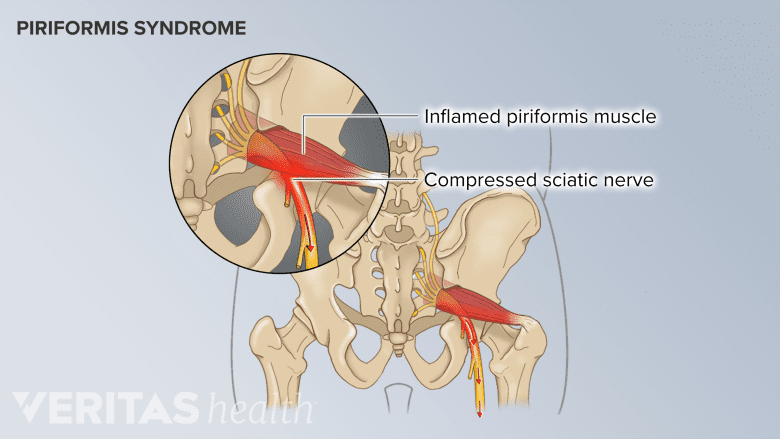While runners are less likely to have back pain,1Maselli F, Storari L, Barbari V, et al. Prevalence and incidence of low back pain among runners: a systematic review. BMC Musculoskelet Disord. 2020;21:343. doi:10.1186/s12891-020-03357-4,2Belavý DL, Quittner MJ, Ridgers N, Ling Y, Connell D, Rantalainen T. Running exercise strengthens the intervertebral disc. Sci Rep. 2017;7:45975. doi:10.1038/srep45975 muscle strains and spinal injuries are still possible. The repetitive impact of running can worsen an existing back injury or trigger a new one. Recognizing and treating symptoms helps prevent most minor back injuries from becoming serious.
Many factors, such as poor running form, weak core muscles, tight hamstrings, training on hard surfaces, and improper running shoes will increase a runner’s risk for back pain and injuries.
In This Article:
Low Back Pain
Low back pain due to muscle strain makes bending and twisting more difficult.
Runners tend to report less low back pain than nonrunners, leading some experts to suggest running is protective.1Maselli F, Storari L, Barbari V, et al. Prevalence and incidence of low back pain among runners: a systematic review. BMC Musculoskelet Disord. 2020;21:343. doi:10.1186/s12891-020-03357-4 However, low back pain is possible, particularly if muscles are weak due to fatigue or a lack of core strength training.
What it is: Most low back pain is believed to be caused by strains and tears to muscles and connective tissues, such as tendons and ligaments. The exact cause of low back pain is unknown in 9 out of 10 cases.1Maselli F, Storari L, Barbari V, et al. Prevalence and incidence of low back pain among runners: a systematic review. BMC Musculoskelet Disord. 2020;21:343. doi:
Piriformis Syndrome

Piriformis syndrome occurs when the piriformis muscle spasms and irritates the sciatic nerve.
This condition is named for the piriformis muscle, which is located deep in the buttock. Piriformis syndrome can be triggered by repetitive leg motion, making it a common source of back-related pain in runners and other athletes.3Hopayian K, Danielyan A. Four symptoms define the piriformis syndrome: an updated systematic review of its clinical features. Eur J Orthop Surg Traumatol. 2018;28(2):155-164. doi:10.1007/s00590-017-2031-8
What it is: This syndrome occurs when the piriformis muscle spasms and compresses the sciatic nerve, a large nerve that travels from the lower spine down the leg.
How it feels: Piriformis syndrome causes pain and tenderness deep in one or both buttocks, underneath the gluteal muscles. Sciatica-like symptoms might be present.3Hopayian K, Danielyan A. Four symptoms define the piriformis syndrome: an updated systematic review of its clinical features. Eur J Orthop Surg Traumatol. 2018;28(2):155-164. doi:10.1007/s00590-017-2031-8
Sciatica

Sciatica occurs when a lumbar spinal nerve root is impinged, causing radiating pain along the sciatic nerve.
Like low back pain, the term “sciatica” describes a painful symptom rather than a medical condition. The medical name for sciatica is radicular pain. There are many possible reasons runners and other people develop sciatica.
What it is: Sciatica, or radicular pain, occurs when a nerve root in the low back gets squeezed or irritated and causes radiating pain to the legs. Muscle spasms in the low back can cause nerve root compression.
Runners may also develop sciatica pain because of damage to the spine, such as a herniated disc or spinal stress fracture.4Hameed F, McInnis KC. Sacral Stress Fracture Causing Radiculopathy in a Female Runner: A Case Report. PM&R. 2011;3(5):489-491. doi:10.1016/j.pmrj.2010.10.009,5Beit Ner E, Rabau O, Dosani S, Hazan U, Anekstein Y, Smorgick Y. Sacral stress fractures in athletes. Eur Spine J. 2022;31(1):1-9. doi:10.1007/s00586-021-07043-4
How it feels: Sciatica pain begins in the lower back and travels down the buttock to the back of the leg. Pain in the buttock or lower leg is often more problematic than the pain in the low back.6Jensen RK, Kongsted A, Kjaer P, Koes B. Diagnosis and treatment of sciatica. BMJ. 2019;367:l6273. doi:10.1136/bmj.l6273 Exactly how sciatic pain feels varies,7Dower A, Davies MA, Ghahreman A. Pathologic Basis of Lumbar Radicular Pain. World Neurosurgery. 2019;128:114-121. doi:10.1016/j.wneu.2019.04.147 ranging from a dull ache to a burning or electric-shock sensation.
Both the spine’s vertebrae and intervertebral discs experience extra pressure each time a runner’s foot impacts the ground.
A Herniated Disc

When a herniated disc compresses a lumbar nerve root, nerve pain or sciatica may occur.
People who run or jog regularly tend to have healthier vertebral discs than people who do not exercise, suggesting runners are less prone to disc herniation.2Belavý DL, Quittner MJ, Ridgers N, Ling Y, Connell D, Rantalainen T. Running exercise strengthens the intervertebral disc. Sci Rep. 2017;7:45975. doi:10.1038/srep45975 Even so, herniated discs are common in elite athletes.8O’Connor SB, Holmberg KJ, Hammarstedt JE, et al. Return-to-Play Outcomes of Athletes After Operative and Nonoperative Treatment of Lumbar Disc Herniation. Curr Rev Musculoskelet Med. 2023;16(5):192-200. doi:10.1007/s12178-023-09829-z
The most common area for discs to herniate is the low back, particularly between the L4-L5 vertebrae and the L5-S1 vertebrae.
What it is: Intervertebral discs have a tough, flexible outer layer and soft inner core. They act as shock absorbers between the spine’s vertebrae. If a disc’s outer layer breaks down and the inner layer bulges or leaks out, it is called a herniated disc.
How it feels: Symptoms vary widely. Some herniated discs do not cause any symptoms. Others cause significant pain and possibly neurological symptoms when the bulging disc or leaking material irritates or compresses nearby nerve tissue. Sciatica, or radicular pain, is also possible.
Sacroiliac (SI) Joint Dysfunction

Too much or too little motion in the SI joint can cause inflammation of the joint’s structures.
Two sacroiliac joints connect the pelvis to the sacrum, a triangle-shaped bone near the bottom of the spine. The sacroiliac joints’ main purpose is to help stabilize the spine and absorb shock during impact, such as when a foot lands on the ground during running.
What it is: The sacroiliac joints have a small range of motion, usually less than 2 mm in any direction.9Kiapour A, Joukar A, Elgafy H, Erbulut DU, Agarwal AK, Goel VK. Biomechanics of the Sacroiliac Joint: Anatomy, Function, Biomechanics, Sexual Dimorphism, and Causes of Pain. International Journal of Spine Surgery. 2020;14(s1):S3-S13. doi:10.14444/6077 When a runner’s sacroiliac joints have too much or too little movement and cause pain, it is called sacroiliac joint dysfunction.
How it feels: Possible symptoms of sacroiliac (SI) joint dysfunction include low back pain felt on one or both sides, pain in the buttocks or side of the thigh, sciatica-like pain, and stiffness.
Because symptoms vary and are similar to those of other conditions, diagnosing sacroiliac joint dysfunction can be challenging.
Other spinal conditions, such as spinal stenosis and spondylolisthesis, tend to be associated with aging and tend to occur in athletes engaged in sports such as diving or gymnastics, and less likely to occur in active runners.
- 1 Maselli F, Storari L, Barbari V, et al. Prevalence and incidence of low back pain among runners: a systematic review. BMC Musculoskelet Disord. 2020;21:343. doi:
- 2 Belavý DL, Quittner MJ, Ridgers N, Ling Y, Connell D, Rantalainen T. Running exercise strengthens the intervertebral disc. Sci Rep. 2017;7:45975. doi:10.1038/srep45975
- 3 Hopayian K, Danielyan A. Four symptoms define the piriformis syndrome: an updated systematic review of its clinical features. Eur J Orthop Surg Traumatol. 2018;28(2):155-164. doi:10.1007/s00590-017-2031-8
- 4 Hameed F, McInnis KC. Sacral Stress Fracture Causing Radiculopathy in a Female Runner: A Case Report. PM&R. 2011;3(5):489-491. doi:10.1016/j.pmrj.2010.10.009
- 5 Beit Ner E, Rabau O, Dosani S, Hazan U, Anekstein Y, Smorgick Y. Sacral stress fractures in athletes. Eur Spine J. 2022;31(1):1-9. doi:10.1007/s00586-021-07043-4
- 6 Jensen RK, Kongsted A, Kjaer P, Koes B. Diagnosis and treatment of sciatica. BMJ. 2019;367:l6273. doi:10.1136/bmj.l6273
- 7 Dower A, Davies MA, Ghahreman A. Pathologic Basis of Lumbar Radicular Pain. World Neurosurgery. 2019;128:114-121. doi:10.1016/j.wneu.2019.04.147
- 8 O’Connor SB, Holmberg KJ, Hammarstedt JE, et al. Return-to-Play Outcomes of Athletes After Operative and Nonoperative Treatment of Lumbar Disc Herniation. Curr Rev Musculoskelet Med. 2023;16(5):192-200. doi:10.1007/s12178-023-09829-z
- 9 Kiapour A, Joukar A, Elgafy H, Erbulut DU, Agarwal AK, Goel VK. Biomechanics of the Sacroiliac Joint: Anatomy, Function, Biomechanics, Sexual Dimorphism, and Causes of Pain. International Journal of Spine Surgery. 2020;14(s1):S3-S13. doi:10.14444/6077

